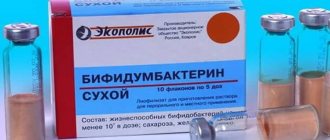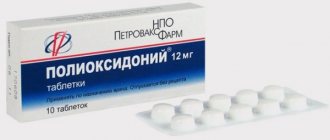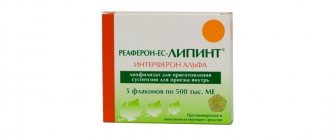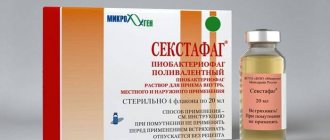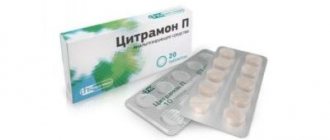Instructions for use of Lactobacterin
The drug Lactobacterin belongs to antidiarrheal microbial agents based on a complex of living microflora. This is a universal medicine with immunomodulatory and antibacterial properties. Lactobacilli populate the lower part of the small intestine and normalize the intestinal microflora and the functions of the gastrointestinal tract, suppress the growth of pathogenic pathogens.
Composition and release form
The drug is produced in the form of a dry powdery substrate from a microbial mass (microorganisms that decompose carbohydrates, during which lactic acid appears), enriched with lactose as a bifidogenic factor (stimulates an increase in the number of bifidobacteria that are part of the healthy intestinal flora). Along with powder, Lactobacterin is available in the form of vaginal suppositories, in liquid form (in bottles) and in tablet form. When calculating the dosage for administration, one dose is taken as a basis.
| Compound | Lactobacillus content |
| Active substance | |
| L. fermentum (strains 39 and 90T-C4); or L. plantarum (strains 38 and 8P-AZ) | 2 -10 9 CFU |
| Excipients | |
| Lactose or milk sugar | |
| Magnesium stearate | |
Pharmacodynamics and pharmacokinetics
Lactobacterin acts due to the dry mass of biologically active lactobacilli that produce lactic acid and can have an effect on pathogenic bacteria, such as enteropathogenic Escherichia coli, staphylococci, Proteus. Systematic use of the drug normalizes the functioning of the gastrointestinal tract, helps restore immunity and optimize metabolic processes.
When using the vaginal form of the drug, lactobacilli convert glycogen accumulated in the epithelium into lactic acid, which begins to inhibit pathogenic microflora and increases the level of resistance of the body. The drug normalizes the microflora in the area where it is used. There is no exact information about the pharmacokinetic characteristics of the drug’s use and metabolism.
Indications for use
Lactobacterin is prescribed to patients who suffer from disorders of the gastrointestinal tract, as well as for diseases in gynecology. List of main indications:
- Patients recovering from acute intestinal infections, when pathogenic microflora or intestinal disorders are detected.
- Somatic diseases aggravated by dysbacteriosis, which appeared due to antibiotic treatment.
- Complex therapy of weak children with pathologies of infectious and non-infectious origin, occurring against the background of atopic dermatitis and dysbiosis.
- Chronic colitis of various etiologies.
- For colpitis, the drug can be used in monotherapy or after completing a course of antimicrobial therapy.
- Vaginal dysbiosis, in which inflammation of the cervix, its body, and appendages develops (after antimicrobial therapy)
- Inflammatory gynecological diseases (adnexitis, urogenital herpes, gonorrhea).
- Preparation for gynecological operations and prevention of complications after them.
- Preparing for childbirth pregnant women whose laboratory tests have revealed a high risk of purulent-septic complications.
Side effects
Lactobacterin is well tolerated by patients of different age categories. The risk of adverse symptoms is minimal. The exception is the presence of lactobacilli intolerance. With this peculiarity of the body, allergic reactions to the drug are possible. Signs of allergy are relieved by symptomatic treatment or discontinuation of the course of taking Lactobacterin.
- See our article “The best folk remedy for gastritis!” To get rid of it QUICKLY and FOREVER...
- How to get rid of gases in the intestines and why do they occur?
- Activated carbon cleaning - is it worth starting?
Overdose
No episodes of Lactobacterin overdose have been recorded in medical practice. The drug is a microbial mass of a live strain of lactobacilli. The safety of the medication composition eliminates the risk of a negative reaction from the body if the dosage is exceeded. This feature is not a basis for violating the instructions or doctor’s orders.
Contraindications
Lactobacterin is prohibited for use in childhood, as well as for:
- candidiasis;
- presence of hypersensitivity.
It is contraindicated to use suppositories from damaged packaging and candles that smell like spoiled vegetable oil.
During pregnancy
Use during pregnancy and breastfeeding is permitted.
How to take Lactobacterin
The method and dosage of treatment with Lactobacterin depends both on the form of the drug and on the diagnosis. First, the main course is carried out, a maintenance dose is prescribed after at least 2-3 weeks (half the dose), for a period of 1-1.5 months. It is recommended to undergo a microflora study two weeks after the start of the course.
Candles
Before inserting the suppository into the vagina, it is necessary to remove the protective packaging material. When carrying out therapy for dysbiosis and colpitis, the drug is prescribed once a day, 1-2 suppositories for 5-8 days. At the same time, the process of restoring the normalization of vaginal secretion to 1-2 degrees and eliminating clinical symptoms in the form of inflammation is monitored. If necessary, the course can be extended to 10-12 days. To prevent the development of purulent-septic complications, use one suppository once a day for 5-7 days before childbirth or surgery.
In ampoules
Before use, you should clarify how many doses are in the ampoule (3, 5 or 10). The contents are diluted with boiled water before use and taken half an hour before meals. Children over 12 years of age and adults are prescribed five doses two to three times a day. The maximum dosage is 15 doses. The duration of therapy depends on the disease. Thus, for nonspecific ulcerative colitis, treatment lasts up to two months, for dysbacteriosis - 3-4 weeks, for dysentery (chronic) 4-6 weeks.
The prepared substance can be used to rinse the mouth and irrigate the genital tract. When used intravaginally, the tampon is soaked in Lactobacterin (five doses in 10 ml of water) and placed in the vagina for three hours. Prenatal preparation involves therapy once a day for seven days. For inflammation, twice a day for 10 days (from the 12th day of the menstrual cycle).
Pills
The tablets are intended for oral administration. Take half an hour before meals, two to three times a day. For acute inflammatory processes, infants are prescribed two to three tablets, adults five tablets. Course duration is 7-8 days. If the patient has a recurrent or protracted form of the disease, then infants are prescribed five tablets for 14-25 days. For diseases of the oral mucosa: 4-6 tablets by sucking two to three times a day for 14-15 days.
Liquid
Reception is carried out in the morning and/or in the evening during meals. Newborn children from one to three years old are prescribed one tablespoon; Children from 3 to 12 years old are prescribed 1.5 tablespoons, children from 12 years old and adults - 2 tablespoons. Before use, the drug must be diluted with boiled water in a 1:1 ratio (temperature no higher than 37 degrees) and shaken. The duration of the course is 14-30 days, it is permissible to conduct it two to three times a year.
Reviews
Among user reviews about the drug there are reviews from doctors. Doctors note that Lactobacterin is a typical probiotic, i.e. a drug containing substances of microbial origin.
This drug, belonging to the first generation of probiotics, is monocomponent, i.e. containing one strain of microorganisms.
Freeze-dried bacteria normalize the microflora of the vagina and intestines. The drug has virtually no side effects, because this physiological agent is well tolerated by patients.
Several forms of release of the drug allow it to be prescribed for various diseases to people of different age groups.
special instructions
It is advisable to combine the use of the drug with the intake of milk or lactic acid products (biokefir). Among the special instructions, the instructions state that the medicine cannot be used if the packaging is damaged, the labeling is missing, the color or consistency of the biomass has changed, foreign inclusions are visible in the bottle, or the expiration date has expired. According to patient reviews, Lactobacterin does not impair concentration and speed of psychomotor reactions. The solution cannot be stored.
- Pain in the middle of the sternum
- Which deposit in Sberbank is better to open?
- Diet menu for hemorrhoids for every day
Release form and composition
Lactobacterin is available in the following forms:
- lyophilisate;
- pills;
- vaginal suppositories.
All forms of the drug contain Lactobacillus acidophilus as an active ingredient. Children are often prescribed a lyophilisate from which a suspension is prepared. It is available in bottles containing 3 or 5 doses of lactobacilli.
One dose is 2 or 4 billion CFU, and one box contains 10 bottles. In addition to dried living bacteria, the preparation contains milk, food gelatin and sugar. The medicine looks like a porous mass or crystals of a yellowish, white-gray or beige color.
Lactobacterin for children
Doctors can prescribe lactobacilli for children in the form of Lactobacterin. The drug can be used as a prophylactic even for newborns. The use of the medication quickly populates the intestines with beneficial microflora, eliminates the symptoms of dyspepsia during artificial feeding, and prevents the development of stool disorders, bloating, frequent regurgitation, and air belching. The drug for newborns restores digestive function, intestinal microflora, prevents increased gas formation and colic.
Rules for taking the drug
First of all, you need to monitor the dosage of the drug, especially in cases where Lactobacterin is taken without a medical prescription.
How to give Lactobacterin for self-treatment? If the baby has undergone antibiotic therapy, in order to restore the intestinal microflora, the drug should be given daily, ¼ teaspoon in the form of a solution. This dosage will be sufficient to treat infectious diseases, but it is best to consult a doctor before starting treatment.
With babies, you should not get carried away with self-medication; in children under six months old, Lactobacterin sometimes causes allergies, as well as side effects such as stomach upset, nausea and vomiting. If these symptoms last more than a day, then you need to stop taking the drug and immediately contact your pediatrician. Some infant formulas are enriched with bifidobacteria, which must also be taken into account when taking the drug.
The medicine is given in liquid form; for this you need to dilute the powder in boiled water.
Drug interactions
It is better to combine the drug with Bifilife and Normaze to enhance the effectiveness of the effect of lactic acid bacteria on the gastrointestinal tract. The product is resistant to antibiotics, so it can be combined with antibacterial therapy, but the effectiveness may be reduced. B vitamins enhance the effect of the drug, so doctors advise accompanying treatment with vitamin therapy. Correction of therapy may be accompanied by the prescription of specific bacteriophages (viruses that destroy certain bacteria). Combination with alcohol is prohibited.
Analogs
There are not many analogues of Lactobacterin. Most of them contain only part of the original components and are similar to it only in terms of efficiency. Popular drug substitutes:
- Bifidumbacterin - probiotic contains bifidobacteria, recommended for use in conjunction with the product in question;
- Trilact, Normoflorin - direct analogues, are liquid concentrates of lactobacilli;
- Acylact, Gerolact - suppositories and tablets based on lactic acid microflora;
- Biobakton – dry lyophilisate for preparing solutions;
- Lactonorm, Ecofemin Balance - vaginal capsules with valuable microflora containing fortelacidophilecofemin.
Indications
Lactobacterin Biopharm is recommended for use in the following cases:
- With a decrease in the level of immunity and protective functions of the body.
- To eliminate allergic reactions to food or chemicals.
- To eliminate unpleasant symptoms during poisoning of various types.
- To restore stable functioning of the stomach after alcohol intoxication.
- During complex treatment of diseases of the stomach, liver, gall bladder and kidneys.
- To eliminate dysbiosis after a long illness, drug treatment or surgery.
- For viral or bacterial infections that cause unpleasant symptoms such as diarrhea, constipation, nausea or bloating.
- In case of a hormonal or enzyme disorder, when the process of absorption of nutrients from food is suspended.
- To eliminate pathogenic microflora in the digestive and genitourinary system.
- During pregnancy, when there is a risk of developing bacterial or viral diseases of the genital organs.
- During breastfeeding, when the baby has digestive disorders.
Price
The cost of purchasing Lactobacterin will depend on the chosen form of the medicine, the volume of packaging and the pricing policy of the retailer. Prices for medications in Moscow will be:
| Variety of Lactobacterin | Price in rubles |
| Vials with lyophilisate 5 doses 10 pcs. | 194 |
| Ampoules with dry powder 5 doses 10 pcs. | 209 |
| Liquid concentrate 10 doses 10 ml | 70 |
| Candles 10 pcs. | 130 |
Types of drug
Any medication is available in a specific form.
Lactobacterin has several such forms:
- vaginal suppositories,
- liquid poured into 10 ml bottles,
- powder, packaged in vials of 10 doses or sachets of 5 doses each,
- tablet form, rarely available for sale.
Absorbed by the mucous membrane, the components of the suppositories quickly produce the necessary therapeutic effect. Other forms of Lactobacterin initially enter the stomach and are broken down in the intestines. Actions have to wait longer; they are aimed at treating pathologies outside the gynecological sphere.
Doctors classify Lactobacterin as probiotics. These include foods, medicines and dietary supplements containing live cultures of microorganisms.
